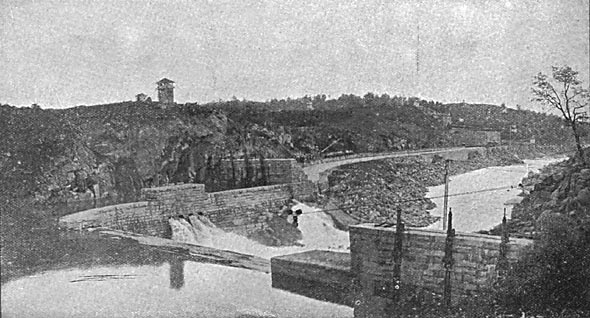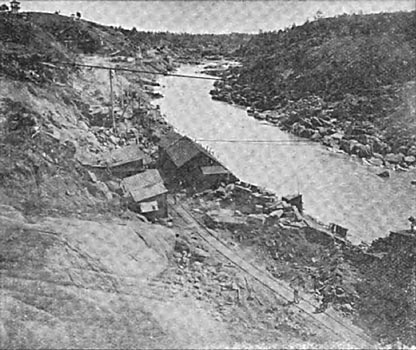[Trade Journal]
Publication: The Electrical Journal
Chicago, IL, United States
vol. 1, no. 2, p. 24-25, col. 1-2
FOLSOM-SACRAMENTO PLANT.
Transmission of Five Thousand Horse Power Over Fifteen Miles — Completion of a Great Commercial Achievement.
SACRAMENTO DRAWS THE EYES OF THE WORLD.
The Sacramento-Folsom transmission plant is practically completed, and will be giving light and power service in the City of Sacramento by June 22nd. This installation will go very far toward settling the question of transmission of energy by electricity, over long distances which we have been waiting for so long.
The distance between Folsom, on the American River, to Sacramento, over the route proposed, is about fifteen miles. The generators used, operate at 800 volts, to step up transformers at 11,000 volts. Under this pressure the current is conveyed over the route to the Sacramento plant where it is retransformed down to 125, 220, 500, 1,000 and 2.000 volts as may be required. The first machine sot in operation is a 1,000 horse power. General Electric, three phase alternating current generator, weighing thirty tons. When the plant is completed, there will be three other machines of the same character and size.
|
The plant is a model of civil, mechanical and electrical engineering. The dam is a massive structure of granite laid in Portland cement. It is 650 feet long, 80 feet high in the centre, Hi feet wide at the base. 20 feet wide in the crest, and contains about 48,500 cubic yards of solid masonry. It is provided with a heavy wooden shutter or dashboard six feet high which at high water is lowered into a recess in the crest of the dam. At low water this shutter is raised by hydraulic pistons, the depth of the basin is increased by six feet and additional storage capacity for the waste water provided. Normally the dam forms a storage basin or reservoir three and one-half miles long, and has a capacity of 18,000,000 cubic yards of water.
At each side of the dam are massive granite bulkheads and three head gates operated by hydraulic machinery, each head gate being 16 feet wide. The West Hide canal is 40 feet wide at the top, 30 feet wide at the bottom, and six feet deep. It is intended principally for irrigation purposes.
The power house is situated at the extreme end of the canal where a fall of 55 feet is available at high water. It is on the west side of the town of Folsom, where an immense cut in solid rock has been made, about 60 feet deep, 100 feet wide, and 150 feet long, from which a channel 40 feet wide leads to the river.
The hydraulic apparatus consists of four pairs of wheels of the McCormick horizontal shaft turbine type, enclosed In steel cases, having steel inlet pipes, eight feet in diameter and double discharge tubes. By this arrangement in pairs, the end thrust is neutralized and sufficient power and speed is developed to allow of direct connection to the generators. Each pair of wheels has a capacity of 1,260 H. P. at 300 revolutions per minute. They embody all that is latest and most improved in hydraulic practice, and are of larger capacity than any hitherto constructed in this country with one exception. They are operated under a head of 55 feet. The hydraulic plant also includes two special horizontal wheels for the exciters. The water after having passed the turbines is discharged through tunnels under the power house into irrigation canals for distribution over the country south and east of Folsom. The wheels and generators are located on the first floor of the building power house sixteen feet above the level of the water in the tail race, but do not occupy the same room. Between the wheel room and the generator room a heavy masonry vault has been built. The openings through which the turbine shafts pass are small and the wall serves to protect the electrical machinery from the possible entrance of water. The water wheel regulators are in the dynamo room and the operator thus has full control of the hydraulic machinery in sight of the electrical instruments on the switchboard. Both dynamo room and wheel room are provided with traveling cranes.
|
In the second story of the power house directly over the dynamo room the substation step-up transformers are Installed. These are the standard type General Electric Company transformers. In these transformers the voltage, generally at 800 volts is raised to 11,000, and connections to the line are made through marble switchboards equipped with necessary switches and fuses. The current is carried at this high voltage over 2,600 40-foot poles, on two circuits of three copper wires each, supported on double petticoated porcelain insulators, each insulator, before use, being exposed to a test of not less than 20,000 volts alternating.
At the substation in Sacramento, the transformer switch board* receive the terminals of the 11,000 volts transmission lines, and operate the different transformer combinations. The transformers at the sub-station are of the air blast type, and vary in size corresponding to the work to Ire performed. Three 300 horse power, three phase synchronous motors. General Electric type, directly connected to a line shaft, drives several 500-volt continuous current railway generators and a number of arc machines.
The incandescent lighting, commercial arc lighting and stationary motor work in the central portion of the city is effected on a low tension modified Edison three wire system, by feeders from the secondaries of the step-down transformers supplying current to a network of mains. The motors arc of the three- phase induction type and capable of connection to the mains at any point. The street arc lighting is done on the constant cur- rent series system, while outlying motors are operated from higher potential lines with individual transformer reduction, or with high potential synchronous motors.
Many features in this plant are improvements over any work of the kind yet attempted, and much interest is aroused in its behalf. It will undoubtedly be the precursor to many similar undertakings, especially in that far Western country, where there is unlimited water, scant fuel and plenty of push.


